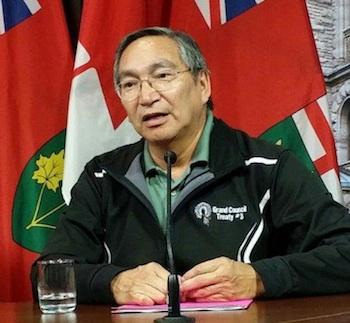Image Caption
Chief Simon Fobister says Ontario Premier Kathleen Wynne has promised to clean the English-Wabigoon River.
“Premier Wynne clearly promised to me that she would clean up our river and the Dryden mill site,” said Fobister. “Premier Wynne promised me that Grassy Narrows would lead the clean-up and that it would begin as soon as humanly possible.
“I welcome this historic commitment and I am eager to work to make this promise a reality so that my people can enjoy our culture and our homeland in health again without fear of an invisible poison. When our fish are safe to eat we will know that this promise has been kept.”
On Friday, Feb. 10, the Premier, along with Minister of the Environment and Climate Change Glen Murray, met with Grassy Narrows and environmentalist David Suzuki.
A statement from the ministry reads ‘Mercury contamination has had a profound impact on the people of Grassy Narrows First Nation and Wabaseemoong (Whitedog) Independent Nations, and has to be properly addressed.”
It says Ontario is “completely committed to working with all partners to identify all potentially contaminated sites, and to creating and implementing a comprehensive remediation action plan for the English Wabigoon River.”
Ontario promised to address mercury contamination in the river by collaborating with the First Nations on solutions based on the best available science and research. Ontario says it’s in the middle of a two-year process designed by Dr. John Rudd, who leads the expert team that is advising Grassy Narrows and is funded by the province.
“This work will inform the extent of the mercury contamination in the river and determine which remediation options may be the most appropriate for each site, including enhanced natural recovery and capping.”
The river has been highly contaminated since 1962 when a paper company in Dryden began dumping 9,000 kg of untreated mercury waste into the river, contaminating the fish and poisoning three generations of people in Grassy Narrows and two neighboring First Nations.
For the past 40 years, Grassy Narrows has been fighting for the clean-up.
“This commitment must be followed by swift action and results so that my people who have been thirsting for justice for 40 years can finally see improvement in their lives,” said Fobister. “I acknowledge our many family members who have suffered terribly from mercury, and our loved ones who have lost their lives to this preventable tragedy. Our ongoing resolve to see this through will honour their memory.”
Last May, scientists indicate that there is an ongoing, but unidentified, source of mercury to the river. The experts have recommended that Ontario find and stop the ongoing source of mercury, while speeding up the natural recovery of the river by augmenting the processes that prevent mercury from entering the food chain.
Mercury contaminated soil was recently found behind the Dryden mill where a former worker says he buried 50 drums of salt and mercury in a shallow pit in 1972.
New information regarding potential mercury contamination at the Domtar Industrial Site in Dryden has also come forward in the last few weeks, reads the government press statement.
“We are now conducting a full and rigorous mercury contamination assessment on the entire mill site, working closely with First Nations and Domtar. The results of this assessment will be shared with the communities. We need to be sure unequivocally if the site is an ongoing source of mercury, and if it is, then we need to work with partners to take all measures to stop further mercury from entering the river.”
Mercury is a potent neuro-toxin that damages the brain and nervous system leading to loss of vision, touch, balance, and coordination as well as learning disabilities with lifelong impacts, reads a press statement from Grassy Narrows.

